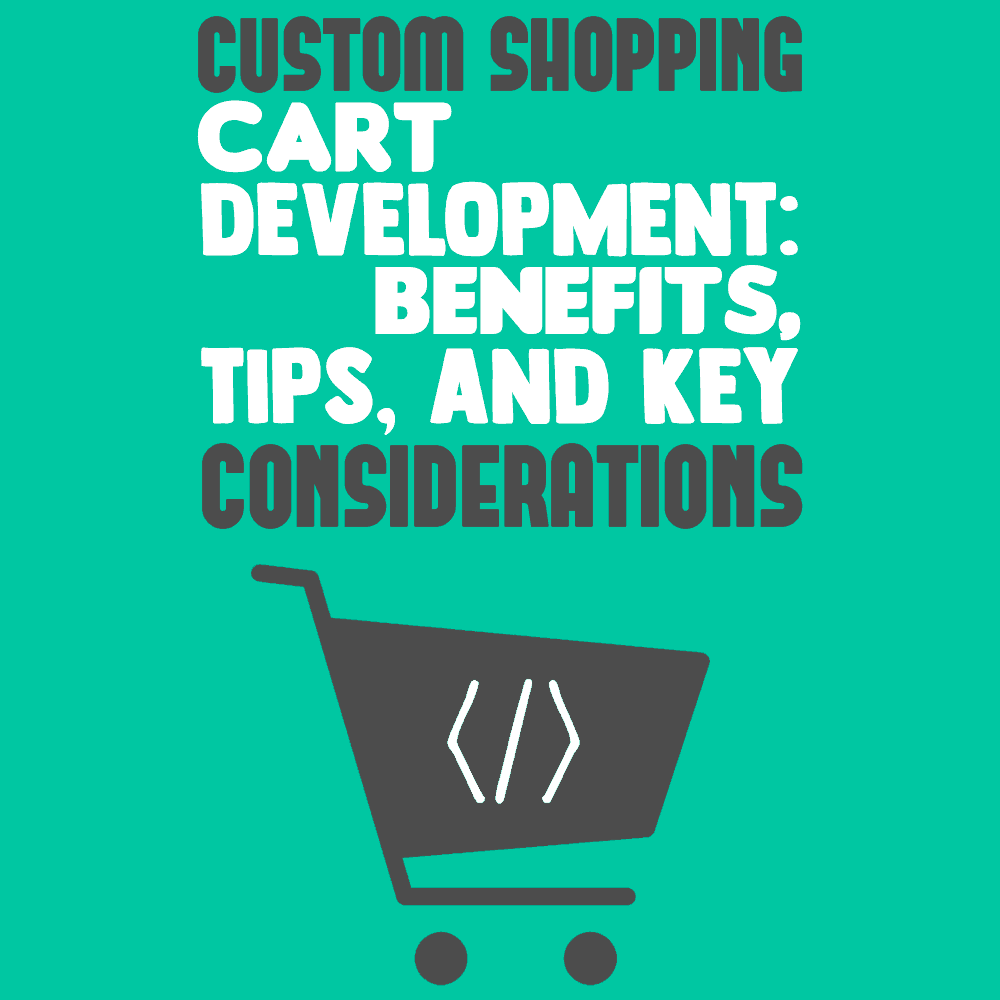
Every e-commerce store needs to have a shopping cart that suits their business goals and their preferences for user experience. Since the abandonment of shopping carts is a common concern for the vast majority of online stores, e-commerce stores need to design carts that can help reduce this problem.
Three out of four shoppers abandon a cart without purchasing. While there are various reasons behind this, a custom shopping cart design can help to avoid this.
Let me explain everything about custom shopping cart design, starting from the very basic definition and different available options, to issues concerning shopping carts, to the effective shopping cart development principles and practices.
The Basics of a Shopping Cart: Purpose and Importance
A shopping cart is nothing but a software solution in an e-commerce website to help users make a purchase of products or services. The shopping cart takes care of processing the customer’s payment and distributing the payment information to the various stakeholders of the process, including merchant, payment processor, and other parties.
Shopping carts help make the connection between noncommital shopping activities like product browsing with actual purchases.
To better understand this, just think of the millions of products browsed in an online store against the products and services actually purchased by the customers. While the shopping and browsing activities remain noncommital, the purchases—which are much lower in number—give the e-commerce store actual business. The shopping cart is the gateway to convert these sales from browsing activities, which is why having quality shopping cart software is crucial.
According to bigcommerce.com, besides leading a customer to the checkout screen, a shopping cart does the following:
- Stores product information
- Works like a gateway for managing orders, catalogue, and customers
- Displays product information, product categories, and website information for the users
To elaborate, an e-commerce shopping cart does a lot more than simply helping you carry items. It is also the shelves holding the products, the clearance counter, the cash register, and the payment processing system.
What Are the Key Options for Shopping Cart Development?
Before we explain custom shopping cart development and the corresponding practices and rules, we need to take a look at the available options. There are basically two types of shopping carts:
Hosted or Generic Shopping Cart Development
When a third-party service provider is responsible for hosting, maintaining, and upgrading the shopping cart, as well as server backups, the cart is referred to as a hosted shopping cart.
The best thing about this type of solution is that hosting the shopping cart doesn’t cost a dime. If shopping cart development cost is your prime consideration, this solution works best. However, the customers will need to go to a different website to process their payment.
Let’s take a deeper look at the pros and cons of hosted shopping carts.
Pros
- It doesn’t add to the cost burden of an e-commerce store.
- It is an easy solution for integrating a shopping cart without going into much complexity.
- This type of shopping cart development is ideal for new business owners who may have little technical knowledge.
Cons
- This type of e-commerce shopping cart development comes as a “one size fits all” solution, which may be completely inappropriate for modern custom e-commerce websites.
- Hosted shopping carts require the customers to go to a different website for processing payments, which is a little cumbersome in terms of user experience.
- Hosted shopping carts lack the flexibility and scope of value additions. As such, carts don’t have many features and are incompatible with third-party add-ons.
Custom or Licensed Shopping Cart Development
When the business owner builds their own shopping cart and customizes it to meet specific requirements and preferences, this is called a custom or licensed shopping cart. This type of shopping cart has more flexible features and allows third-party add-ons.
Here are some more pros and cons of custom shopping carts:
Pros
- Custom shopping carts offer a broader scope of customization, which is befitting for custom e-commerce web development.
- By addressing specific business requirements and client preferences, custom shopping carts actually help deliver a better customer experience and the consequent scope of business conversion.
- Custom shopping carts also allow adding third-party tools to ensure a lot of additional value in the customer experience.
Cons
- Building a custom shopping cart is more expensive compared to the readymade solutions.
- Unlike readymade shopping carts, custom carts are tested by just a few people and hence, are more prone to development errors.
The Key Issues Concerning Shopping Carts
Before we can know how custom shopping carts can help the user experience, we need to evaluate the problems faced by e-commerce shoppers.
As I have already mentioned, the vast majority of e-commerce stores suffer from the problem of cart abandonment leading to severe loss of business. This is why the issues concerning shopping carts need to be evaluated and explained in detail.
When analyzing the phenomenon of cart abandonment, I observed that many cases involve a few common issues:
- Hidden costs like shipping charges are the most common reason for abandoning a shopping cart. Around one-fourth of customers cite shipping cost as a reason to leave their cart without purchasing. On the other hand, lesser or discounted shipping charges often lead to bigger and more consistent sales conversions. Free shipping remained a big impetus for shopping, and it helps convert the cart into sales more consistently.
- Another common reason is the nonavailability of the preferred method of payment. For example, in many markets cash on delivery is the preferred payment method, and without seeing this method in the list of payment avenues, customers often leave the cart. According to a recent survey conducted by ClickandBuy, many online retailers are losing potential sales because of not being able to provide a large range of payment methods. The survey says that 50% of online shoppers will cancel a purchase if their preferred method is not available.
- A lengthy and mandatory registration process is often responsible for customers abandoning shopping carts. Don’t make it mandatory to register, as you can always accommodate new customers with a guest login. Even when registering customers, keep the process limited to a few steps.
- Failure to establish credibility and trust is another reason for shoppers leaving a shopping cart. To establish trust and credibility of your brand, make sure all pages have real customer reviews, no 404 links, and enhanced server capability to handle increased peak-hour traffic without dropping the performance. The trusted logos from VeriSign, Google Trusted Store, PayPal verified, McAfee secure, etc. can also put a lot of weight behind your store.
- Price comparison to your competitors may cause you to lose customers, but you can try to prevent this by explaining the added value that can convince customers to opt for your product.
How Can You Convince Your Shoppers to Finish the Purchase?
Shoppers leave carts for all sorts of reasons, including going to other competitor’s sites to take advantage of a discount or a competitive rate.
This regularly contributes to a considerable loss of customers who buy from other competitor websites. According to maxtraffic.com, more than 80% of e-commerce stores have a firm belief that abandoned shopping carts are lost forever, and there is no point in pursuing those customers to complete their purchases. However, customers often abandon carts while meaning to come back.
Now, it is important to understand how an e-commerce store can convince customers to come back and finish a purchase. eCommerce shopping cart development is incomplete without options like “Add to Wishlist” and “Save Cart,” as these functions can open communication with the customer.
The e-commerce store can inform the customers about similar products, promotions, or limited-time offers. The “Save Cart” function also helps the store contact the customers by creating a sense of urgency with the use of discounts and offers.
Custom Shopping Cart Development: How You Can Do It

While the shopping cart remains the heart and soul of e-commerce stores, customizing the carts to the specific business needs and the audience is a key success factor for the online store.
As online stores face all-around competition in marketing their merchandise and reaching customers far and wide, a quality shopping cart can play an invaluable role in making the shopping experience better.
While the benefits of custom shopping carts in converting business stand out, let’s explain how to do it. You need to consider a couple of key questions related to the performance of your shopping cart and business conversion:
What Features Should a Shopping Cart Have?
Considering the high standard of user experience and audience engagement, you need to be uncompromising with certain shopping cart features.
- You need to make sure that the customers visiting your store are able to browse the products in multiple ways. The shopping cart should offer multiple filter options to allow customers to search for products by brand, material, price, category, colour, and other options.
- The shopping cart should incorporate product ratings and reviews to build credibility and reliability.
- Lastly, there should be a smooth checkout process equipped with multiple payment options and gateways.
Should You Incorporate Custom Elements or Develop the Cart From Scratch?
When you want to use custom shopping carts for your e-commerce store, you have both the option of incorporating custom features over your existing shopping cart solution or building a custom cart right from the beginning.
If you can’t hire a technically skilled and experienced software developer team to build your custom shopping cart, you can make value additions to your existing cart and offer many custom features and functions.
Some of the key features to create additional value for your e-commerce store include tracking orders, providing a fast-paced express checkout, having promotional offers, and creating a custom wardrobe or a wishlist.
Most Effective Tips for Custom Shopping Cart Design and Development
A custom shopping cart requires both a customized design and a feature set. I’ll explain a few design and development tips for custom shopping carts in an online store. Let’s start with the basic design tips and steps:
- Instead of going for the default design of the e-commerce CMS, evaluate the merits of designing for the specific requirements of your store. If you need to incorporate new elements or make improvements, go for it.
- You can tweak the “Background Graphic,” “Background Color,” and “Header Graphic” design one by one to give shape to your preferred shopping cart design.
- Similarly, by going to the Product tab, you can choose custom or thumbnail images for specific products.
- Add a short and engaging description to each and every product.
Key Parameters to Watch Out for in Shopping Cart Development and Design
When you build a shopping cart, you need to watch out for certain parameters to ensure optimum performance and a user-friendly experience:
- Cart-Opening Speed –The speed of cart opening is crucial to the performance and user experience. Ideally, a shopping cart should be opened and closed in a few milliseconds. As most customers leave a store with delayed loading time, you need to give high priority to loading speed.
- Use of Local Currency – While the default currency for any shopping cart is USD, you should always make it possible to use local currency. For products, taxes, and shipping costs, using local currency will provide standout advantages.
- Product Shipping Options – As shipping is one of the problematic areas pulling down your business conversion, you need to offer multiple product shipping options to help customers choose one they prefer. A wider number of shipping options will help generate the e-confidence of customers.
How a Custom Shopping Cart Boosts Your Business

We’ve already looked at the basic differences between custom and generic shopping carts, but let’s take a deeper look at how a custom cart can boost user experience and sales over a generic shopping cart. While custom shopping carts may involve dealing with development, design and testing complexities, and considerable budget, a generic one can be used without facing these challenges.
The custom shopping cart offers a whole array of advantages in terms of enhanced engagement and business conversion, while the generic carts just lack essential elements to convert business into modern e-commerce web stores:
- Unique User Experience – A shopping cart flaunting a custom design means it is specifically made for a selective audience. The design decisions are reached based upon the functions and features the online store needs to provide its customers. Apart from having a unique look, the design should also provide optimum ease for browsing products.
- Flexible Product Listing – One of the biggest limitations of generic carts is that they do not allow tweaking of the product listing. For example, under a certain filter, like price or category, a generic cart may not allow listing too many or an unlimited number of products. In complete contrast, under any filter option or category, a custom cart can list as many products as are available with appropriate pagination or scrolling options.
- Running Special Promotion – When you go for custom shopping cart development, your store can list products for special promotions and offers in a separate page. Obviously, the listing of products under a special promotional page helps to boost business conversion and sales.
- Enhanced Control – Generic carts are normally hosted in a remote server controlled by a hosting company. This means limited access and control. Moreover, you need to rely on the security settings of a server that can have its own vulnerabilities. Custom shopping carts offer total control and access to all records and data. As you also have control over the source code and root database, you can configure security settings to your preference.
- Faster Incorporation of Changes – When you need to incorporate some changes to your generic shopping cart, with a generic cart all you can do is to implement the changes on templates of both the client and server sides. This makes the process complex and time-consuming. In contrast, custom shopping carts can easily incorporate changes and allow modifications faster without many complexities to deal with.
- Increased Scalability – The generic shopping cart has hardly any scalable capacity that allows it to grow with your e-commerce business. You have to work with a limited-capacity cart that never meets the demand of your growing e-commerce business. In contrast, a custom cart offers optimum scalability to adapt to increased traffic and business queries.
- Marketing – Generic carts offer no special marketing features. Custom shopping carts, in contrast, offer a lot to help in promoting and marketing products. The e-commerce store can include individual SEO tags for each of the listed products and all the pages to increase traffic generated through search engine results.
- Elaborate Pricing Choices – With a generic shopping cart, you only have fixed pricing options that come pre-configured. In contrast, with the custom cart, you can create elaborate pricing options for different product categories. At the same time, custom carts allow you to incorporate promotional offers and discounts within the pricing mix to make the product listing more lucrative.
Custom Shopping Carts: An Investment That’s Worthwhile
If you want to build a highly competitive e-commerce store, complete with an exhaustive range of features, functions, and design elements for converting business, embracing a custom approach for shopping carts is now a primary requirement.
Only custom-designed carts can help an e-commerce store address specific user needs and preferences. Custom shopping cart development can be a little expensive, but it’s worth the cost when you consider the unmatched business advantages offered.
